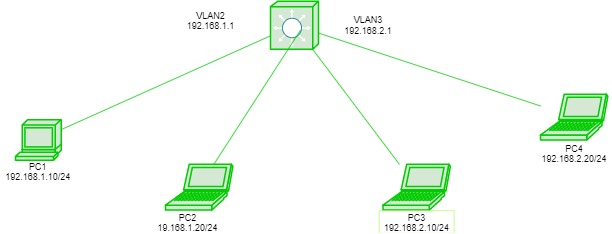Inter VLAN Routing by Layer 3 Switch
Last Updated :
02 May, 2023
Prerequisite – Access and trunk ports
Normally, Routers are used to divide the broadcast domain and switches (at layer 2) Operate in a single broadcast domain but Switches can also divide the broadcast domain by using the concept of VLAN (Virtual LAN).
VLAN is the logical grouping of devices in the same or different broadcast domains. By default, all the switch ports are in VLAN 1. As the single broadcast domain is divided into multiple broadcast domains, Routers or layer 3 switches are used for intercommunication between the different VLANs.The process of intercommunication of the different Vlans is known as Inter Vlan Routing (IVR).
Suppose we have made 2 logical groups of devices (VLAN) named sales and finance. If a device in the sales department wants to communicate with a device in the finance department, inter-VLAN routing has to be performed. These can be performed by either router or layer 3 switches.
Switch Virtual Interface (SVI): SVI is a logical interface on a multilayer switch that provides layer 3 processing for packets to all switch ports associated with that VLAN. A single SVI can be created for a VLAN. SVI on the layer 3 switch provides both management and routing services while SVI on layer 2 switch provides only management services like creating VLANs or telnet/SSH services.
Process of Inter Vlan Routing by Layer 3 Switch: The SVI created for the respective VLAN acts as a default gateway for that VLAN just like the sub-interface of the router (in the process of Router On a stick). If the packet is to be delivered to different VLANs i.e inter VLAN Routing is to be performed on the layer 3 switch then first the packet is delivered to the layer 3 switch and then to the destination just like in the process of the router on a stick.
Configuration:

Here is a topology in which we have a layer 3 switch connected to host devices namely PC1, PC2, PC3, PC4. The hosts PC1, PC2 will be in Vlan 10, and PC3, PC4 will be in Vlan 20. Giving IP addresses to All hosts. PC1-192.168.1.10/24, PC2-192.168.1.20/24, PC3 – 192.168.2.10/24, PC4-192.168.2.20/24.
Now creating VLANs on layer 3 switches namely VLAN 2 on the switch ports fa0/1, 2 and fa0/3, 4 for VLAN 3.
Switch# vlan 2
Switch# vlan 3
Switch# int range fa0/1-2
Switch# switchport access vlan 2
Switch# int range fa0/3-4
Switch# switchport access vlan 3
Now creating SVI for VLAN 2 giving it IP address 192.168.1.1/24 and SVI for VLAN 3 giving IP address 192.168.2.1/24
Switch# ip routing
Switch# int vlan 2
Switch# ip address 192.168.1.1 255.255.255.0
Switch# int vlan 3
Switch# ip address 192.168.2.1 255.255.255.0
Now if we will try to ping PC1 to PC4.
The packet is first delivered to switch then to the destination. As the destination is present in other networks, the packet will be first delivered to the switch which has an SVI for both VLANs (acts as gateway).
Advantages:
In the Router on the stick method, both switch and router are needed but while using layer 3 switches, a single switch will perform inter-VLAN routing as well as the layer 2 functions (Vlan), therefore this method is cost-effective and also less configuration is needed.
- Speed: Inter-VLAN routing by Layer 3 switch is faster than other methods, as the Layer 3 switch can perform the routing process quickly, without requiring the intervention of an external router.
- Cost-effective: Using a Layer 3 switch for inter-VLAN routing can be more cost-effective than using a separate router, as it eliminates the need for an external router and its associated costs.
- Scalability: Inter-VLAN routing by Layer 3 switch is scalable, as additional VLANs can be added easily without significant changes to the network topology.
- Security: Inter-VLAN routing by Layer 3 switch provides better security than other methods, as it allows for the creation of access control lists (ACLs) to restrict traffic between VLANs.
Disadvantages:
- Complexity: Inter-VLAN routing by Layer 3 switch can be complex to configure and manage, particularly in large networks with many VLANs.
- Limited functionality: Layer 3 switches have limited routing capabilities compared to dedicated routers, which can limit the routing options available to network administrators.
- Single point of failure: If the Layer 3 switch used for inter-VLAN routing fails, all traffic between VLANs will be disrupted, which can cause significant network downtime.
- Bandwidth utilization: Inter-VLAN routing by Layer 3 switch can lead to increased bandwidth utilization, as all traffic between VLANs must pass through the Layer 3 switch, which can create a bottleneck if not properly managed.
Application of Inter VLAN Routing by Layer 3 Switch:
1.Network Division: Inter VLAN directing permits network chairmen to partition the organization into various intelligent portions or VLANs. Each VLAN can have its own IP subnet and security approaches, which further develops network execution and security.
2.Virtualization: Inter VLAN directing is a fundamental part of organization virtualization, which empowers different virtual organizations to coincide on a similar actual organization foundation. This empowers productive utilization of assets and takes into consideration better organization adaptability.
3.Load Adjusting: Inter VLAN directing can be utilized to stack balance traffic between VLANs. By circulating traffic across different VLANs, network heads can forestall bottlenecks and further develop network execution.
4.Access Control: Inter VLAN directing can be utilized to apply access control strategies to traffic between VLANs. For instance, network managers can utilize access control records (leg tendons) to control traffic among VLANs and implement security strategies.
5.Voice over IP (VoIP): Inter VLAN directing is basic for VoIP executions, which require various VLANs to help various sorts of traffic. VoIP traffic should be isolated from different sorts of traffic to guarantee nature of administration (QoS), and between VLAN steering empowers this division.
Share your thoughts in the comments
Please Login to comment...